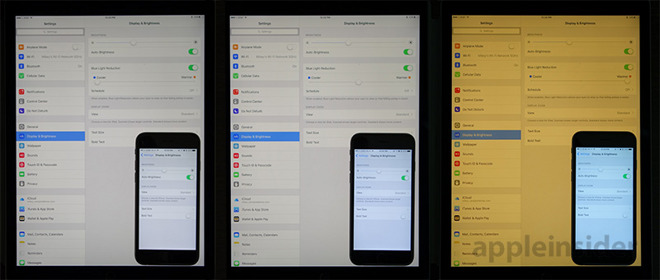It's easy to dismiss Apple's new Night Shift mode -- introduced in iOS 9.3 -- as a gimmicky bolt-on, but it's actually a helpful feature rooted in years of sleep science.

Composite series showing iPhone 6s running iOS 9.2 atop iPad Pro running iOS 9.3 with Night Shift.
Night Shift performs essentially the same function on iOS devices as desktop apps like f.lux long have on the Mac: as your bed time approaches, it automatically shifts the color temperature of your display toward the warmer end of the spectrum. You might not know what color temperature is, exactly, but you've probably heard of it -- whenever someone describes a smartphone display as "more yellow" or "more blue," they're talking about its color temperature.
Just like traditional color theory, color temperature in lighting is expressed on a warm-to-cool scale. Yellows and reds are warm, while blues and whites are cool.
LED-based lightbulbs are a great analog: LED bulbs that appear harsh white have a cool temperature, while those that seem more like a traditional incandescent bulb are warmer.
So why does this matter to Apple? Because years of scientific research has concluded that light has a noticeable impact on brain function, especially sleep.
Human beings fall asleep courtesy of a chemical called melatonin. Meltaonin is light-sensitive; when your eyes detect light, melatonin production is suppressed, making it more difficult to nod off.
Night Shift's warmest setting approximates the color of the setting sun.
Studies have shown that when it comes to melatonin suppression, all lights are equal -- but blue lights are more equal than others.
In one study highlighted by the National Institute of Health, "exposing healthy subjects to 30 minutes of 500 lux polychromatic blue light an hour before bedtime, in their natural home environment, delayed the onset of rapid eye movement sleep by 30 minutes."
"I'm pretty sure that at least many of the sleep disorders we are facing epidemically are related to evening or nighttime light," said Dieter Kunz, former director of the Sleep Research and Clinical Chronobiology Research Group at Berlin teaching hospital Charite-Universitatsmedizin.
Another joint study concluded that "the use of these devices before bedtime prolongs the time it takes to fall asleep, delays the circadian clock, suppresses levels of the sleep-promoting hormone melatonin, reduces the amount and delays the timing of REM sleep, and reduces alertness the following morning."
Many professionals go so far as to recommend that people who have trouble falling asleep avoid all contact with backlit electronic screens for an hour before going to bed. Unfortunately, that's simply not realistic in the days of eBooks and the internet, which is where Night Shift comes in.
By shifting the color temperature of the display automatically, Night Shift reduces the amount of blue light emitted by your devices. While this won't entirely solve the problem, it does help a great deal -- a success that multiple members of the AppleInsider staff will attest to.


